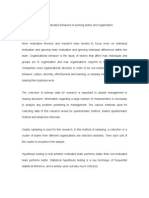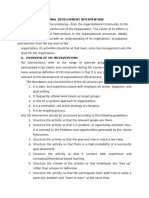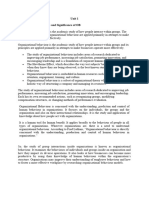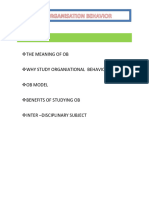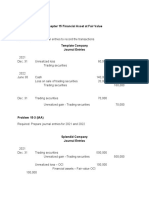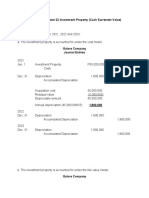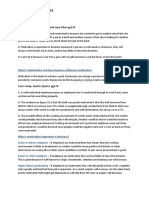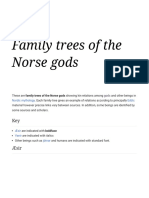1 The Nature and Scope of Organizational Behavior
1 The Nature and Scope of Organizational Behavior
Uploaded by
WeStan LegendsCopyright:
Available Formats
1 The Nature and Scope of Organizational Behavior
1 The Nature and Scope of Organizational Behavior
Uploaded by
WeStan LegendsOriginal Title
Copyright
Available Formats
Share this document
Did you find this document useful?
Is this content inappropriate?
Copyright:
Available Formats
1 The Nature and Scope of Organizational Behavior
1 The Nature and Scope of Organizational Behavior
Uploaded by
WeStan LegendsCopyright:
Available Formats
1 THE NATURE AND SCOPE OF ORGANIZATIONAL BEHAVIOR
Learning Objectives
1. Explain what is organizational behavior.
2. Summarize the research methods of organizational behavior.
3. Identify the benefits of studying organizational behavior knowledge.
4. Explain key events in the history of organizational behavior.
5. Understand how a person develops organizational behavior skills.
A. THE MEANING AND RESEARCH METHODS OF ORGANIZATIONAL BEHAVIOR
The Meaning of Organizational Behavior
Organizational behavior (OB) is the study of human behavior in the workplace, the
interaction between people and the organization, and the organization itself. It is the study
of how people behave in organizational settings. Its principles are applied with the goal of
making organizations and the people in them work more effectively together.
Organizational behavior research can focus on individual behavior within the
organization, how groups work together, how the organization itself behaves, and how all of
these are interconnected and impact each other.
The goals of OB are to explain, predict, and control behavior.
Importance of Organizational Behavior
The principles of effective organizational behavior can be applied to many aspects of
the workplace. It can be used to improve productivity and performance, boost employees’
satisfaction, increase motivation, foster better leadership, understand decision-making, and
facilitate better cross-team collaboration.
As an academic discipline, organizational behavior is studied in many business
administration programs. Organizational behavior is also researched and applied by a
number of business roles, such as consultants or organizational management experts.
Types of organizational behavior models
Organizational behavior has been studied for decades, leading to a number of
theories and models on effective organizational management. The following five
management models make up a popular framework for thinking about organizational
behavior:
Autocratic: This model can be used to best describe historical workplaces,
particularly those during the industrial revolution. An autocratic model is based on power
and authority, demands employee obedience, and is built on dependency on the boss for
directions. Jobs within the autocratic model may provide no more than a paycheck for their
employees.
Custodial: A custodial model is built on providing a sense of security and care from
the organization to employees, such as through providing a strong benefits package. The
aim with the custodial model is to provide incentives and economic resources that will build
loyalty toward the organization.
Supportive: A supportive model is built on leadership motivating and inspiring
workers. Unlike the autocratic model, it assumes that employees are self-motivated. So a
manager’s job is to help foster that motivation by supporting the employee’s talents,
interests, and goals. This is built with the understanding that with the right support,
employees will take initiative and increase performance on their own.
Collegial Unlike the first two models, the collegial model acknowledges that social
factors are a key factor in employee satisfaction. This model is built on the idea of colleagues
working together as a team and fostering a sense of partnership. Power within the
organization is shared to a certain degree and it could feature a flattened hierarchy without
direct top-down direction.
System: This is the newest organizational behavior model, built on fostering
passion and a commitment to the organization’s goals. The idea is that by giving employees
a high level of meaning at work, workers will achieve greater satisfaction and performance .
This system expects managers to show compassion and care toward their direct reports and
work to establish a positive workplace culture.
Influences of organizational behavior
There are hundreds of factors that can influence organizational behavior. For example,
one of the earliest OB studies was designed to investigate how lighting impacts
productivity (in the process, the researchers discovered workers responded more to social
factors than environmental ones).
Influential factors can generally be boiled down to a few main groups:
Social: Leadership styles, coworker personalities, group dynamics, relationships, etc.
Environment: Lighting, aesthetics, office/desk set-up, etc.
Structure: Employee hierarchy, organizational structure of departments in business
units, etc.
Tools: Access to information, tools, and technology
Processes: Workflow management, reporting structures, project management styles,
etc.
B. RESEARCH METHODS OF ORGANIZATIONAL BEHAVIOR
1. Methods of data collection. Three frequently used methods of collecting data in
organizational behavior are surveys, interviews, and direct observation of behavior. The
type of survey questionnaire used by an organizational behavior specialist is prepared
rigorously.
Chapter 1/The Nature and Scope of Organizational Behavior 3
Survey Questionnaire – design to measure relevant issues about the topic being
employed.
Interview - used to obtain ideas for survey questions. It is helpful in uncovering
explanations about phenomena and furnishing leads for further inquiry.
Systematic observations – are made about the phenomena under study. One concern
about this method is that the people under observation may perform typically when
they know they are being observed.
Participant observation – the observer becomes a member of the group about which he
or she collects information.
2. Research methods. Four widely used research methods of organizational behavior
are case studies, laboratory experiments, field experiments (or studies), and meta-
analysis.
Case study - is usually collected by an observer recording impressions in his or her
mind or on a notepad. It provide a wealth of information that can be used to explain
what is happening in a given situation.
Experiment – is the most rigorous research method. The essence of conducting an
experiment is making sure that the variable being modified(the independent
variable) influences the results. The independent variable is thought to influence the
dependent variable. The dependent variable is also known as the criterion (or
measure).
Laboratory experiments – Is that conditions are supposedly under the
experimenter’s control. A group of people might be brought into a room to
study the effects of stress on problem-solving ability
Field Experiments – attempt to apply the experimental method to real life
situations. Variables can be controlled more readily in the laboratory than in
the field, but information obtained in the field is often more relevant.
Meta-analysis- is a quantitative or statistical review of the literature on a particular
subject, and is also an examination of a range of studies for reaching a combined
results or best estimate. Meta-analysis is also a study of studies combining
quantitative information from them all. An important use of meta-analysis in
organizational behavior is to understand how moderator variables influence the
results of studies. An example would be how stress from personal life can influence
susceptibility to job stress.
B. BENEFITS FROM STUDYING ORGANIZATIONAL BEHAVIOR
Organizational behavior relates to the process—rather than the content—of
conducting managerial work.
1. Skill Development
An essential requirement for entering into, surviving, and succeeding in the
modern workplace is to have appropriate skills. Organizational behavior skills have
gained in importance in the modern workplace. A survey of 1,420 CIOs found that
53 percent of these managers offered information technology employees training
In areas outside of technology. Soft skills generally refer to interpersonal skills such
as motivating others, communicating, and adapting to people of different cultures.
Hard skills generally refer to technical skills.
2. Personal Growth through Insight Into Human Behavior
Understanding others leads to personal fulfillment, and can also lead to enhanced
self-knowledge and self-insight. Insight is useful for such purposes as selecting
people for jobs and assignments, communicating, and motivating.
3. Enhancing Organizational and Individual Effectiveness
An important goal of organizational behavior is to improve organizational
effectiveness, the extent to which an organization is productive and satisfies the
demands of its interested parties. Substantial evidence has accumulated that
emphasizing the human factor increases productivity and gives a firm a competitive
advantage. One reason is that people-oriented management practices enable work
orders to use their wisdom and to receive appropriate training.
If a person develops knowledge about subject such as improved interpersonal
communication, conflict resolution, and teamwork, he or she will become more
effective.
4. Sharpening and Refining Common Sense
Organizational behavior sharpens and enlarges the domain for common sense.
Organizational behavior knowledge also refines common sense by challenging you
to reexamine generally accepted ideas that may be only partially true—such as
inactivity reduces stress for everybody.
D. A BRIEF HISTORY OF ORGANIZATIONAL BEHAVIOR
The history of organizational behavior is rooted in the behavioral approach to
management, the belief that specific attention to workers’ needs creates greater
satisfaction and productivity.
A common theme of the behavioral approach is a need to focus on people.
Five key developments in the history of organizational behavior are the classical
approach to management, the Hawthorne studies, the human relations movement,
the contingency approach to management and leadership, and positive organizational
behavior.
1. The classical approach to management encompasses scientific management and
administrative management, and contributed some insights into understanding workplace
behavior.
The focus of scientific management was the application of scientific methods to
increase individual worker’s productivity. According to the principles of scientific
management, there is a division of work between managers and workers.
Administrative management was concerned primarily with how organizations
should be managed and structured. The core of management knowledge lies within the
classical school, including the framework of planning, organizing, and controlling.
Chapter 1/The Nature and Scope of Organizational Behavior 5
2. The Hawthorne Studies. Without the insights gained from the Hawthorne studies,
organizational behavior might not have emerged as a discipline. The first Hawthorne study
examined the effects of lighting on productivity. A second study conducted in a relay
assembly room examined the relationships among rest, fatigue, and productivity. A major
conclusion from these studies was the workers reacted positively because management
cared about them (the Hawthorne effect). The Hawthorne effect is the tendency of people
to behave differently when they receive attention because they respond to the demands of
the situation.
The Hawthorne studies also led to many other conclusions, such as the fact that
effective communication with workers is critical to managerial success. Keep in mind that
the Hawthorne studies have frequently been criticized for lacking in scientific rigor.
3. The Human Relations Movement. The human relations movement was based
on the belief that an important link exists among managerial practices, morale, and
productivity. Key points of the movement are that satisfied workers are more productive
and that, given the proper working environment, virtually all workers would be highly
productive. A cornerstone of the human relations movement is Theory X and Theory Y of
Douglas McGregor. Theory X is the somewhat stern and pessimistic traditional assumptions
about worker capabilities. Theory Y is an alternative, and optimistic, set of assumptions.
4. The Contingency Approach. The contingency approach to management
emphasizes there is no one best way to manage people or work. The contingency approach
is derived from the study of leadership styles. The strength of the contingency approach is
that it encourages managers and professionals to examine individual and situational
differences before deciding on a course of action.
5. Positive Organizational Behavior. An emerging movement in organizational
behavior is a focus on what is right with people. Luthans defines positive organizational
behavior as the study and application of human resource strengths and psychological
capacities that can be measured, developed, and managed for performance improvement.
The criteria of being measurable and developmental are significant because they separate
positive organizational behavior from simply giving pep talks and inspirational speeches to
employees. In general, positive organizational behavior focuses on developing human
strengths, making people more resilient, and cultivating extraordinary individuals, work
units, and organizations.
E. SKILL DEVELOPMENT IN ORGANIZATIONAL BEHAVIOR
Developing skills in organizational behavior refers to learning to work effectively with
individuals, groups, and organizational forces. Skill development in organizational
behavior follows a general learning model, using the following components:
1. Conceptual information and behavioral guidelines. Each chapter in this book
presents research-based information about organizational behavior including a section
titled “Implications for Management Practice.”
2. Conceptual information and examples. These include brief descriptions of
organizational behavior in action, generally featuring managers and leaders.
3. Experiential exercises such as self-assessment exercises. The book provides an
opportunity for practice and personalization through cases and self-assessment exercises.
Self-quizzes are included because they are an effective method of helping you personalize
the information, assisting you in linking conceptual information to your own situation. For
example, you will read about creative problem solving and also complete a quiz about
creativity.
4. Feedback on skill utilization or performance, from others. Feedback exercise
appears at several places in the book. Implementing organization behavior skills outside the
classroom will provide additional opportunities for feedback
5. Frequent practice. Reader who look for opportunities to practice organizational
behavior skills outside the classroom will acquire skills more quickly. An important example
is the development of creative thinking skills. The person who looks for imaginative
solutions to problems regularly is much more likely to become a more creative thinker, and
be ready to think creatively at a given moment. Contrast this with the individual who
participates in a creative-thinking exercise once, and then attempts the skills a year later
when the need is urgent. As in any field, frequent practicing s skill the right way leads to skill
improvement.
Developing organizational behavior skills is also important because it contributes to
lifelong learning.
F. A FRAMEWORK FOR STUDYING ORGANIZATIONAL BEHAVIOR
The three levels of study in organizational behavior are (a) individual level, (b)
groups and interpersonal relations level, and (c) organizational system and the global
environmental level.
Figure 1.1
Individuals
Individual differences, mental, ability,
and personality
Learning, perception, and attribution
Attitude, values, and ethics Group and Interpersonal Relations
Individual decision making and creativity Interpersonal communication
Foundation concepts of motivation Group dynamics
Motivational methods and programs Teams and teamwork
Leadership in organizations
Power, politics, and influence
Conflict, stress, and well being
The Organizational System and
the Global Environment
Organizational structure and design
Organizational culture
Organizational change and knowledge
management
Cultural diversity and international organizational
Visualize a behavior famous athletic
team with a winning history. Many fans
Chapter 1/The Nature and Scope of Organizational Behavior 7
contend that the spirit and tradition of the team, rather than individuals’ capabilities, carry it
through to victories against tough opponents. Yet if the team has a couple of poor recruiting
years or lose a key coach, it may lose frequently.
Key factors in understanding how individuals’ functions include individual
differences, mental ability and personality, learning, perception, attitudes, values
attribution, and ethics. It is also important to understand individual decision making
creativity, foundation concepts of motivation, and motivational programs.
As suggested by the arrows in Exhibit 1.1, the various levels of study are
interconnected. Understanding how individuals behave contributes to an understanding of
groups and interpersonal relations, the second level of the framework.
VI. IMPLICATIONS FOR MANAGERIAL PRACTICE
Managers should raise their level of awareness about the availability of organizational
behavior information. Before making decisions about dealing with people, pause to
search for systematic information about people and organizations. Search for
strengths and talents in others and yourself, and then capitalize on these strengths as a
way of improving organizational and individual effectiveness.
You might also like
- Ethical Issues in Operation ManagementDocument4 pagesEthical Issues in Operation Managementlalsingh50% (2)
- Learning in Action: A Guide to Putting the Learning Organization to WorkFrom EverandLearning in Action: A Guide to Putting the Learning Organization to WorkRating: 3 out of 5 stars3/5 (1)
- Ivy League Reference Letters 30 Successful Business School MBA RecommendationsDocument50 pagesIvy League Reference Letters 30 Successful Business School MBA RecommendationsSnehansh SatiNo ratings yet
- Assignment-3 1Document3 pagesAssignment-3 1WeStan LegendsNo ratings yet
- Yr 7 Genes Activity Pack Part 1Document50 pagesYr 7 Genes Activity Pack Part 1Vvi MedinaNo ratings yet
- Significance of Organisational Behaviour - For MergeDocument4 pagesSignificance of Organisational Behaviour - For MergeIqra Rajput60% (5)
- Module 4: Unit 1 Exercise 1. Answer The Following QuestionsDocument2 pagesModule 4: Unit 1 Exercise 1. Answer The Following QuestionsWeStan LegendsNo ratings yet
- The Eaves of Heaven by Andrew X. Pham - ExcerptDocument25 pagesThe Eaves of Heaven by Andrew X. Pham - ExcerptCrown Publishing Group100% (9)
- Surface Tension of Water From: AlcoholDocument4 pagesSurface Tension of Water From: AlcoholSkandar EverestNo ratings yet
- Casi ResueltoDocument4 pagesCasi ResueltoQ Bustincio JC100% (2)
- Dubrin IM Ch01-4Document6 pagesDubrin IM Ch01-4Dave Dinopol100% (1)
- Ob Lecture1Document22 pagesOb Lecture1kamathputsNo ratings yet
- Chapter 1 The Nature and Scope of Organizational BehaviorDocument4 pagesChapter 1 The Nature and Scope of Organizational BehaviorJohn lordrie HerreraNo ratings yet
- Chapter 1obDocument13 pagesChapter 1obfiseha bekeleNo ratings yet
- 4res1 041080298 Tma2Document10 pages4res1 041080298 Tma2Sk LowNo ratings yet
- 09 - 00 - 30 - 18 - 12 - 2022 - Organisational Behavior by Anjali Mam NOTESDocument168 pages09 - 00 - 30 - 18 - 12 - 2022 - Organisational Behavior by Anjali Mam NOTESPapa DeltaNo ratings yet
- Organization Behaviour UNIT 1Document11 pagesOrganization Behaviour UNIT 1shaik9391469742No ratings yet
- Johns 10e Irm ch01Document30 pagesJohns 10e Irm ch01Jacob WeiseNo ratings yet
- Johns 10e Irm ch01 PDFDocument30 pagesJohns 10e Irm ch01 PDFJacob Weise100% (1)
- Case StudiesDocument45 pagesCase StudiesmariaNo ratings yet
- MNGTDocument17 pagesMNGTBELMONTE, Christian Justin R.No ratings yet
- Research Methodology in CommerceDocument31 pagesResearch Methodology in Commerceadeeba_kazii80% (5)
- Part IIIDocument8 pagesPart IIIMary Jane Arca IntaoNo ratings yet
- Obhrm Unit-1-1Document19 pagesObhrm Unit-1-1Abhishek KunchalaNo ratings yet
- Organizationz DevelopmentDocument2 pagesOrganizationz Developmentm.elawady5074No ratings yet
- Unit I Organization Behaviour MeaningDocument53 pagesUnit I Organization Behaviour MeaningakmNo ratings yet
- Unit 1Document20 pagesUnit 1Prakrity JaiswalNo ratings yet
- Introduction To Organizational BehaviorDocument8 pagesIntroduction To Organizational BehaviorBedri M AhmeduNo ratings yet
- Organisational Behaviour Aayushi - Patel Roll No - 30Document22 pagesOrganisational Behaviour Aayushi - Patel Roll No - 30Aayushi PatelNo ratings yet
- Organisational Behaviour Importance and Fields of StudyDocument10 pagesOrganisational Behaviour Importance and Fields of Studyarjun Singh100% (1)
- Organizational Behavior Is A Field of Study That Investigates The Impact That IndividualsDocument7 pagesOrganizational Behavior Is A Field of Study That Investigates The Impact That IndividualsThinesh Rau KrishnamurtyNo ratings yet
- Apeksha - FINALDocument69 pagesApeksha - FINALkhayyumNo ratings yet
- And Store Valuable Knowledge and That Ability To Acquire and Use KnowledgeDocument3 pagesAnd Store Valuable Knowledge and That Ability To Acquire and Use KnowledgeHaru HaruNo ratings yet
- 2.significance of ObDocument9 pages2.significance of ObPiyush SinglaNo ratings yet
- Tragedies Like The Challenger Catastrophe Can Be The Result of A Lack of Organisational IntegrityDocument4 pagesTragedies Like The Challenger Catastrophe Can Be The Result of A Lack of Organisational Integritydudde niranjanNo ratings yet
- Org Behavior IntroDocument32 pagesOrg Behavior Introkristina.limarenko7No ratings yet
- Module - 1: The Meaning of ObDocument11 pagesModule - 1: The Meaning of ObJyoti DateerNo ratings yet
- Abm-801 Iii UnitDocument13 pagesAbm-801 Iii Unitch meghana100% (1)
- Organizational DevelopmentDocument6 pagesOrganizational DevelopmentMizan HawladerNo ratings yet
- Organizational Dynamics and ObjectivesDocument42 pagesOrganizational Dynamics and ObjectivesAadith AarjayNo ratings yet
- Importance of OBDocument25 pagesImportance of OBaadinath9535No ratings yet
- Behaviour of the organizationDocument39 pagesBehaviour of the organizationrebecashundaNo ratings yet
- ITM Unit 5Document10 pagesITM Unit 5Ashish GuptaNo ratings yet
- Dynamics of People and OrganizationDocument3 pagesDynamics of People and OrganizationLyka AlvarezNo ratings yet
- OD InterventionsDocument41 pagesOD InterventionsDr. Sujoy SenNo ratings yet
- OB AviDocument66 pagesOB AviAwais SiddiquiNo ratings yet
- Employee Empowerment ProjectDocument75 pagesEmployee Empowerment ProjectAjith KumarNo ratings yet
- Org. Behaviour1Document93 pagesOrg. Behaviour1Benjamin Adelwini BugriNo ratings yet
- 8615 2nd AssignmentDocument22 pages8615 2nd Assignmentanni khanNo ratings yet
- Participation and Empowerment 1Document7 pagesParticipation and Empowerment 1Shankar MahantiNo ratings yet
- Week 13 CompleteDocument14 pagesWeek 13 CompleteNeuf RochesNo ratings yet
- Organisational Development Interventions: Beckhard Lists Six Such AssumptionsDocument8 pagesOrganisational Development Interventions: Beckhard Lists Six Such AssumptionsPijush Kumar BiswasNo ratings yet
- Organizational BehaviorDocument18 pagesOrganizational BehaviorPow dowtowNo ratings yet
- Notes Ob PDFDocument55 pagesNotes Ob PDFworkwithkabeerNo ratings yet
- UntitledDocument70 pagesUntitledzynulabidNo ratings yet
- Organizational Behavior: The Dynamic of People and OrganizationDocument15 pagesOrganizational Behavior: The Dynamic of People and OrganizationAl MamunNo ratings yet
- Chapter One Introduction To Research: Learning OutcomesDocument6 pagesChapter One Introduction To Research: Learning OutcomesKevin MothaNo ratings yet
- Organizational Behavior 1Document11 pagesOrganizational Behavior 1RiajNo ratings yet
- Ob Unit 1 and 2 PtuDocument32 pagesOb Unit 1 and 2 PtuAK47 GamingNo ratings yet
- What Is Organizational BehaviorDocument27 pagesWhat Is Organizational BehaviorAK47 GamingNo ratings yet
- OB Notes 1Document42 pagesOB Notes 1asimNo ratings yet
- Chapter 1 and 2... Real OneDocument18 pagesChapter 1 and 2... Real OneAdrita DasNo ratings yet
- Organizational BehaviourDocument100 pagesOrganizational BehaviourKlovenide7100% (2)
- Mod 6Document13 pagesMod 6Nikita SangalNo ratings yet
- Ob Question Bank- BbambaDocument109 pagesOb Question Bank- BbambaDiksha PandeyNo ratings yet
- Stat Analysis 1Document1 pageStat Analysis 1WeStan LegendsNo ratings yet
- Cbmec-4 1Document2 pagesCbmec-4 1WeStan LegendsNo ratings yet
- Assignment5.1 CBMEC Chapter5Document2 pagesAssignment5.1 CBMEC Chapter5WeStan LegendsNo ratings yet
- Fin Mar Chapter 1 EssayDocument1 pageFin Mar Chapter 1 EssayWeStan LegendsNo ratings yet
- Pastoral SocietiesDocument2 pagesPastoral SocietiesWeStan LegendsNo ratings yet
- Assignment 2.1 OMDocument2 pagesAssignment 2.1 OMWeStan LegendsNo ratings yet
- Stat AnalysisDocument1 pageStat AnalysisWeStan LegendsNo ratings yet
- RPH AssignmentDocument5 pagesRPH AssignmentWeStan LegendsNo ratings yet
- Ia Activity 4Document23 pagesIa Activity 4WeStan LegendsNo ratings yet
- IA Activity 6 AssDocument6 pagesIA Activity 6 AssWeStan LegendsNo ratings yet
- Assignment 1.1 PMDocument1 pageAssignment 1.1 PMWeStan LegendsNo ratings yet
- Summary Organizational CultureDocument3 pagesSummary Organizational CultureWeStan LegendsNo ratings yet
- Activity 5 - Chapter 22 Investment Property (Cash Surrender Value) Problem 22-2 (IFRS)Document6 pagesActivity 5 - Chapter 22 Investment Property (Cash Surrender Value) Problem 22-2 (IFRS)WeStan LegendsNo ratings yet
- SummarizationConflict and StressDocument12 pagesSummarizationConflict and StressWeStan LegendsNo ratings yet
- Behavioral Principles of InnovationDocument1 pageBehavioral Principles of InnovationWeStan LegendsNo ratings yet
- Introduction and Review of Basic Concepts ExercisesDocument6 pagesIntroduction and Review of Basic Concepts ExercisesWeStan LegendsNo ratings yet
- MMW Assignment 4.6Document2 pagesMMW Assignment 4.6WeStan LegendsNo ratings yet
- Business Process ReengineeringDocument2 pagesBusiness Process ReengineeringWeStan LegendsNo ratings yet
- Litratures of The WorldDocument22 pagesLitratures of The WorldWeStan LegendsNo ratings yet
- MMW Assignment 4.5Document1 pageMMW Assignment 4.5WeStan LegendsNo ratings yet
- Plate 13 Vergilius Romanus CDocument2 pagesPlate 13 Vergilius Romanus Cjanari64No ratings yet
- Chapter 21 - MotivationDocument4 pagesChapter 21 - MotivationAliNo ratings yet
- Pablo P. Garcia V. Yolanda Valdez Villar G.R. No. 158891, June 27, 2012, J. Leonardo-DecastroDocument2 pagesPablo P. Garcia V. Yolanda Valdez Villar G.R. No. 158891, June 27, 2012, J. Leonardo-DecastroBianca Nerizza A. Infantado IINo ratings yet
- Silver or Lead - Darcy HalifaxDocument252 pagesSilver or Lead - Darcy HalifaxNoor Fadhul100% (1)
- THE PASSION OF OUR LORD JESUS CHRIST (Good Friday)Document8 pagesTHE PASSION OF OUR LORD JESUS CHRIST (Good Friday)John Carl Aparicio100% (1)
- Notice 12605 31 Oct 2024Document212 pagesNotice 12605 31 Oct 2024Sumit RaghuvanshiNo ratings yet
- Freud Two Principles SchreberDocument8 pagesFreud Two Principles SchreberChris L. SmithNo ratings yet
- Circuit Theory Analysis Lecture Notes All Unit PDFDocument259 pagesCircuit Theory Analysis Lecture Notes All Unit PDFDeivasigamani Subramaniyan100% (2)
- Computer Organization Lab 17012013Document22 pagesComputer Organization Lab 17012013R K S B O TNo ratings yet
- 6 Consequences of PlagiarismDocument2 pages6 Consequences of PlagiarismkumarNo ratings yet
- Physics - Centripetal Force Lab ReportDocument6 pagesPhysics - Centripetal Force Lab Reporttonytono100% (2)
- Jakub Jakubec, Vladimír Kutiš, Juraj Paulech, Gabriel GálikDocument5 pagesJakub Jakubec, Vladimír Kutiš, Juraj Paulech, Gabriel GálikMuhammad FattahNo ratings yet
- Family Trees of The Norse Gods: Nordic Mythology EddicDocument10 pagesFamily Trees of The Norse Gods: Nordic Mythology EddicRichard R.IgnacioNo ratings yet
- speech analysisDocument2 pagesspeech analysismamanochristine005No ratings yet
- Edu O11Document9 pagesEdu O11Precious Mae Bucad BuloNo ratings yet
- A People s Curriculum for the Earth 1st Edition Bill Bigelow download pdfDocument55 pagesA People s Curriculum for the Earth 1st Edition Bill Bigelow download pdfmelbinmauza100% (3)
- Spotify Case Study PaperDocument14 pagesSpotify Case Study Paperapi-507098917No ratings yet
- Lesson Plan 3Document4 pagesLesson Plan 3Romy Renz SanoNo ratings yet
- G.R. No. 181416, November 11, 2013Document2 pagesG.R. No. 181416, November 11, 2013leo.rosario100% (1)
- Unexplained Mystery #1: Bigfoot (Aka Sasquatch)Document11 pagesUnexplained Mystery #1: Bigfoot (Aka Sasquatch)Meghana ReddyNo ratings yet
- Geographical Indications Burkhart GoebelDocument13 pagesGeographical Indications Burkhart GoebelAVNISH PRAKASHNo ratings yet
- C Programming File: Submitted By: MCA (I Yr - 2009)Document56 pagesC Programming File: Submitted By: MCA (I Yr - 2009)durga_prasad11511No ratings yet
- Marketing PlanDocument21 pagesMarketing PlanNurullah Mohiuddin MalekNo ratings yet
- TDS DocumentDocument34 pagesTDS DocumentSaleem JavedNo ratings yet
- Topic 2B Abridged Tejeros ConventionDocument6 pagesTopic 2B Abridged Tejeros ConventionCindy-chan DelfinNo ratings yet














